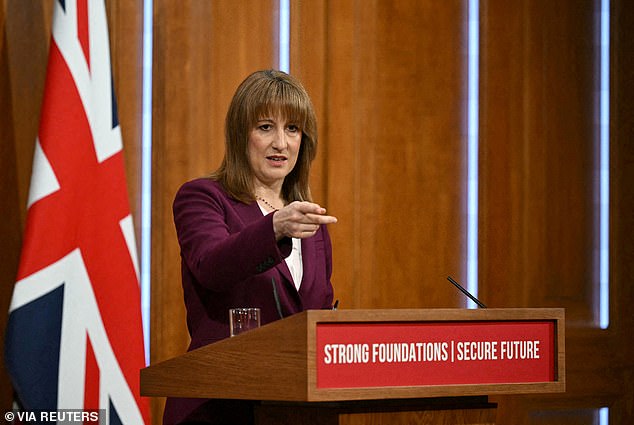Rachel Reeves might have ducked raising income tax rates, but households can still expect to be hit with a tax raid in next week’s Budget.
The Chancellor is now widely expected to extend the freeze on income tax thresholds until 2030.
Tax thresholds have not kept up with the cost of living, since former Chancellor Rishi Sunak froze them at 2021 levels at the tail end of the Covid pandemic.
This has created a colossal tax raid through a phenomenon known as fiscal drag. As wages tend to rise with inflation, frozen thresholds drag more lower earners into paying tax while the number of taxpayers pushed in higher bands increases.
Someone who earned £25,000 in 2020 would have lost £2,306 in extra income tax since then due to the frozen starting threshold for basic rate tax.
Meanwhile, a worker on £50,000 five years ago would be down £10,638 by today, due to the higher rate threshold stalling.
You can work out how much fiscal drag has cost you using our calculator below. Put in either your 2020 salary, which we will uprate for inflation, or your actual annual earnings for each year.
Frozen bands: The Chancellor is expected to keep income tax thresholds at their current rate until 2030
Where should tax thresholds be?
In the last Budget, Reeves said the threshold freeze would last until 2028/29, before they were uprated in line with inflation again.
Now it appears the Chancellor will U-turn and continue the freeze in a bid to plug the £20billion black hole in the public finances. This could raise £8billion a year by 2030, a similar amount to adding 1p on basic rate tax, according to IFS projections.
If the personal allowance had increased in line with CPI, it would have increased from £12,570 to £16,243. If the 40p tax higher rate threshold had risen with inflation, it would be £64,959, up from the current £50,270.
A worse hand has been dealt to those even further up the income scale, as the threshold for the 45p additional rate of income tax was cut by Jeremy Hunt from £150,000 to £125,140 from April 2023.
If the original £150,000 threshold had been uprated for inflation, people would only pay the additional tax rate on earnings over £193,831.
This fiscal drag compounded over the years has put millions more taxpayers in the higher and additional rate bands, leaving them paying thousands more a year.
How our fiscal drag calculator works
Our stealth tax fiscal drag calculator will show you how much the threshold freeze has cost you since 2020 in cumulative terms and each year.
You can either put in your 2020 salary and the calculator uprates it for inflation, working out how much you lost to frozen thresholds each year, or you can put in your actual earnings for each individual year.
Figures do not take into account pension contributions, student loans and National Insurance.
Fiscal drag affects people across the income scale but the greatest impact is for high earners and those who have moved up an income tax band due to it.
Our calculator includes the impact of the additional rate band falling from above £150,000 to above £125,140 in 2023.
Someone earning £145,000 in 2020 has lost a cumulative £15,689 to fiscal drag and the lower threshold since then.
Someone on £75,000 in 2020 has lost £11,530, while someone on £48,000 in 2020 has lost £8,492, as their pay has broken through the 40p threshold that failed to move up.
Lower earners and pensioners are being stung by the stealth tax too, as the starting threshold for 20p basic rate tax has been stuck at £12,570.
Someone with an income of £15,000 in 2025 has paid £2,306 more in tax.
A middle earner on £35,000 in 2020 is also down £2,306 due to the freeze.
Shaun Moore, tax and financial planning expert at Quilter said:’ If the government extends the freeze into future years, it pours fuel on the fire.
‘Fiscal drag becomes a defining feature of the tax system, with more and more people becoming higher rate taxpayers simply because inflation did the heavy lifting for the Treasury.’
By 2030, the personal allowance should be £17,704 according to the OBR’s inflation projections. While taxpayers would only start to pay the higher rate at £70,801, and the additional rate threshold would have been £211,263 if there were no fiscal drag.
SAVE MONEY, MAKE MONEY

Sipp cashback

Sipp cashback
£200 when you deposit or transfer £15,000

4.56% cash Isa

4.56% cash Isa
Trading 212: 0.71% fixed 12-month bonus

£20 off motoring

£20 off motoring
This is Money Motoring Club voucher

Free shares bundle

Free shares bundle
Get free UK shares worth up to £200

4.45% Isa with bonus

4.45% Isa with bonus
Now with no penalty for withdrawals
Affiliate links: If you take out a product This is Money may earn a commission. These deals are chosen by our editorial team, as we think they are worth highlighting. This does not affect our editorial independence. Terms and conditions apply on all offers.
dailymail,money,tax
#frozen #tax #thresholds #cost #fiscal #drag #calculator #reveals #pain

